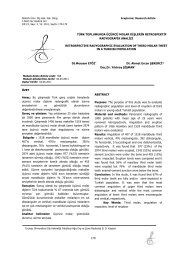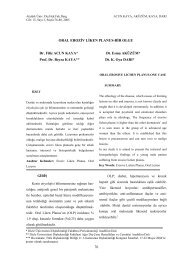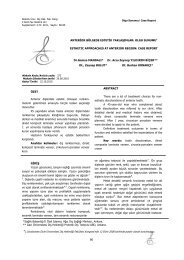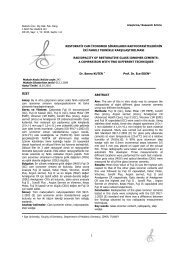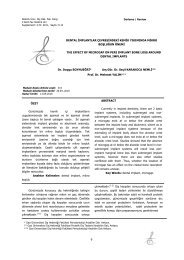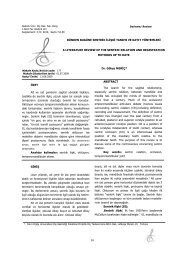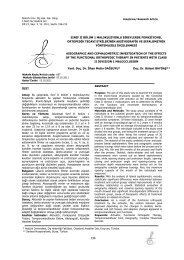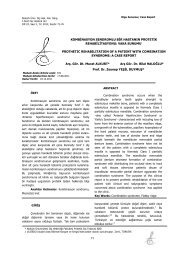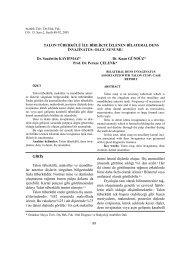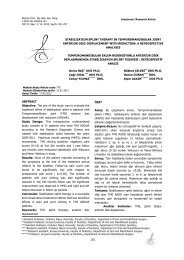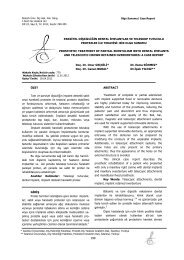a comparison of the accuracy of two different apex locators
a comparison of the accuracy of two different apex locators
a comparison of the accuracy of two different apex locators
Create successful ePaper yourself
Turn your PDF publications into a flip-book with our unique Google optimized e-Paper software.
Atatürk Üniv. Diş Hek. Fak. Derg.<br />
J Dent Fac Atatürk Uni<br />
Cilt:22, Sayı: 2, Yıl: 2012, Sayfa: 132-137<br />
Araştırma/ EVCİL, ERSOY, Research YEŞİLDAL Article YETER,<br />
ÇOLAK TOPCU<br />
Makale Kodu/Article code: 685<br />
Makale Gönderilme tarihi: 06.10.2011<br />
Kabul Tarihi: 28.12.2011<br />
A COMPARISON OF THE ACCURACY OF TWO DIFFERENT APEX<br />
LOCATORS USING DIFFERENT ROOT CANAL SOLUTIONS<br />
FARKLI KANAL YIKAMA SOLÜSYONLARI KULLANILARAK İKİ<br />
FARKLI APEKS BULUCUNUN DOĞRULUĞUNUN<br />
KARŞILAŞTIRILMASI<br />
Doç. Dr. M.Sinan EVCİL*<br />
Arş. Gör. Dt. İbrahim ERSOY**<br />
Arş. Gör. Dt. Kübra YEŞİLDAL YETER** Doç. Dr. K. Meltem COLAK TOPCU*<br />
ÖZET<br />
Aim: The aim <strong>of</strong> this study was to investigate whe<strong>the</strong>r <strong>the</strong><br />
Apex Pointer EAL (Electronic Apex Locator) or <strong>the</strong> Propex EAL<br />
can give actual working length measurements in dry canals<br />
or canal irrigated with NaOCl, EDTA, or saline.<br />
Material and Methods: Thirty-one human premolar and<br />
incisor teeth with single roots were used in this study. To<br />
determine <strong>the</strong> actual working length, a number 10 K-file was<br />
progressed as far as <strong>the</strong> major foramen under a<br />
stereomicroscope. When <strong>the</strong> tip <strong>of</strong> <strong>the</strong> K-file was visible in<br />
<strong>the</strong> major apical foramen, a silicon stopper was immediately<br />
adjusted to <strong>the</strong> canal surface. The K-file was removed from<br />
<strong>the</strong> root canal and <strong>the</strong> distance between an endodontic ruler<br />
and <strong>the</strong> silicon stopper was measured. These measurements<br />
were selected as <strong>the</strong> control group. Then, measurements<br />
were performed with both <strong>the</strong> Propex EAL and Apex Pointer<br />
EAL under <strong>different</strong> conditions (dry, NaOCl, EDTA, and<br />
saline). A measurement was deemed unstable when <strong>the</strong><br />
reading <strong>of</strong> <strong>the</strong> EAL did not remain stable for at least 5<br />
seconds. The stable measurements were selected as <strong>the</strong><br />
study group.<br />
Results: The rate <strong>of</strong> <strong>the</strong> accurate measurements with <strong>the</strong><br />
Propex were 35% at ± 0.5 mm and 70% at ±1 mm in dry<br />
canals; 26% at ±0.5 mm and 58% at ±1 mm in canals with<br />
NaOCl; 58% at ± 0.5 mm and 90% at ±1 mm in canals with<br />
saline; and 26% at ±0.5 mm and 71% at ±1 mm in canals<br />
with EDTA. The rate <strong>of</strong> <strong>the</strong> with <strong>the</strong> actual measurements<br />
with <strong>the</strong> Apex Pointer were 35% at ±0.5 mm and 61% at ±1<br />
mm in dry canals; 26% at ±0.5 mm and 45% at ±1 mm in<br />
canals with NaOCl; 45% at ±0.5 mm and 70% at ±1 mm in<br />
canals with saline; and 54% at ±0.5 mm and 80% at ±1 mm<br />
in canals with EDTA. None <strong>of</strong> <strong>the</strong> tested devices delivered an<br />
actual measurement <strong>of</strong> 100%. However, <strong>the</strong> differences<br />
between control and study groups in all samples were not<br />
statistically significant.<br />
Conclusion: Therefore, both <strong>the</strong> Propex EAL and Apex<br />
Pointer can be used safely to determine <strong>the</strong> actual working<br />
length.<br />
Keywords: Working length, Propex EAL, Apex Pointer EAL<br />
ABSTRACT<br />
Amaç: Bu çalışmanın amacı Apex Pointer EAL (Elektronik<br />
Apeks Bulucu) ve Propex EAL’nin kuru veya NaOCl, EDTA ve<br />
salin solüsyonu ile yıkanmış kanallarda gerçek çalışma<br />
uzunluğunu verip vermediğini incelemektir.<br />
Gereç ve Yöntem: Bu çalışmada 31 tek köklü premolar ve<br />
kesici insan dişi kullanıldı. Gerçek çalışma boyutunu<br />
belirlemek için 10 numaralı K tipi kanal eğesi bir<br />
steromikroskop altında majör foramene kadar ilerletildi. Kanal<br />
eğesinin ucu majör apikal foramende görüldüğü zaman<br />
silikon bir stoper hemen kanal yüzeyine ayarlandı. Kanal<br />
eğesi kök kanalından çıkarıldı ve endodontik cetvel ile silikon<br />
stoper arasındaki mesafe ölçüldü. Bu ölçümler kontrol gurubu<br />
olarak kabul edildi. Sonraki ölçümler hem Propex EAL hem de<br />
Apex Pointer EAL ile farklı koşullar altında (kuru, NaOCl,<br />
EDTA ve saline) yapıldı. EAL’nin okuması en az 5 saniye<br />
stabil kalmadıkça o ölçüm “stabil değil” şeklinde kabul edildi.<br />
Stabil ölçümler çalışma gurubu olarak dahil edildi.<br />
Bilgular: Propex ile yapılan değerlendirmeler; kuru<br />
kanallarda ±0.5 mm de %35 ve ±1 mm de %70, NaOCl’li<br />
kanallarda ±0.5 mm de %26 ve ±1 mm de %58, salin<br />
sulüsyonu ile yıkanan kanallarda ± 0.5 mm de %58 ve ±1<br />
mm de %90 ve EDTA’lı kanallarda ±0.5 mm de %26 ve ±1<br />
mm de %71 gerçek boyuta yakın değerler gösterdi. Apex<br />
Pointer ile yapılan değerlendirmeler; kuru kanallarda ±0.5<br />
mm de %35 ve ±1 mm de %61, NaOCl’li kanallarda ±0.5<br />
mm de %26 ve ±1 mm de %45, salin sulüsyonu ile yıkanan<br />
kanallarda ± 0.5 mm de %45 ve ±1 mm de %70 ve EDTA’lı<br />
kanallarda ±0.5 mm de %54 ve ±1 mm de %80 gerçek<br />
boyuta yakın değerler gösterdi. Test aletlerinin hiçbiri %100<br />
gerçek boyut doğruluğu göstermedi. Bununla birlikte tüm<br />
örneklerde çalışma ve kontrol gurubu arasındaki farklılıklar<br />
istatistiksel olarak anlamlı değildi.<br />
Sonuç: Bu nedenle hem Propex EAL hem de Apex Pointer<br />
gerçek çalışma boyutunu belirlemede güvenle kullanılabilir.<br />
Anahtar Kelimeler: Çalışma boyutu, Propex EAL, Apex<br />
Pointer EAL<br />
* Associated Pr<strong>of</strong>essor, Department <strong>of</strong> Endodontic, Faculty <strong>of</strong> Dentistry, Ataturk University, Erzurum, Turkey<br />
** Research Assistant, Department <strong>of</strong> Endodontic, Faculty <strong>of</strong> Dentistry, Ataturk University, Erzurum, Turkey<br />
132
Atatürk Üniv. Diş Hek. Fak. Derg.<br />
J Dent Fac Atatürk Uni<br />
Cilt:22, Sayı: 2, Yıl: 2012, Sayfa: 132-137<br />
EVCİL, ERSOY, YEŞİLDAL YETER,<br />
ÇOLAK TOPCU<br />
INTRODUCTION<br />
Although it is difficult to measure an exact<br />
working length under clinical conditions, <strong>the</strong>re is a<br />
consensus on <strong>the</strong> importance <strong>of</strong> an actual working<br />
length determination. 1 The apical construction, where<br />
<strong>the</strong> pulp tissue is connected to <strong>the</strong> periodontal tissue,<br />
is accepted as <strong>the</strong> appropriate landmark. This<br />
construction, also referred as <strong>the</strong> foramen minor, 2 is<br />
<strong>the</strong> narrowest part <strong>of</strong> <strong>the</strong> root canal treatment in <strong>the</strong><br />
apical area that treatment should be terminated. The<br />
apical construction is <strong>the</strong> end-point <strong>of</strong> <strong>the</strong><br />
instrumentation and <strong>the</strong> obstruction. The tooth pulp is<br />
also <strong>the</strong> narrowest at that point and <strong>the</strong> healing <strong>of</strong> <strong>the</strong><br />
pulp wound is more favourable. 3 The apical<br />
construction is thought to be located 0.5 or 1mm, on<br />
average, short <strong>of</strong> <strong>the</strong> anatomical <strong>apex</strong>. Damaging <strong>the</strong><br />
apical construction is reported to cause tissue<br />
destruction, inflammation, and foreign body reaction<br />
in <strong>the</strong> apical tissue following <strong>the</strong> over-limitation <strong>of</strong> root<br />
filling. 4 Generally, <strong>the</strong> working length is measured<br />
using periapical radiography. In this method, <strong>the</strong> tip <strong>of</strong><br />
a file is inserted in <strong>the</strong> root canal and <strong>the</strong> distance<br />
between <strong>the</strong> tip <strong>of</strong> <strong>the</strong> file and tip <strong>of</strong> <strong>the</strong> radiographic<br />
<strong>apex</strong> is measured. However, determination <strong>of</strong> <strong>the</strong><br />
working length with this method may be difficult<br />
because <strong>of</strong> <strong>the</strong> superimposition <strong>of</strong> anatomical<br />
structures (i.e., zygomatic arch, maxillary sinus, etc.).<br />
Because periapical radiography has <strong>two</strong> dimensions, it<br />
cannot show <strong>the</strong> bucco-lingual curvature. For <strong>the</strong>se<br />
reasons, new devices, called <strong>the</strong> electronic <strong>apex</strong><br />
<strong>locators</strong> (EALs), 5 have been developed to determine<br />
<strong>the</strong> actual working length.<br />
One <strong>of</strong> <strong>the</strong> most important issues in endodontic<br />
studies is <strong>the</strong> determination <strong>of</strong> <strong>the</strong> actual working<br />
length before <strong>the</strong> treatment. With technological<br />
developments, <strong>apex</strong> <strong>locators</strong> are now being used to<br />
determine <strong>the</strong> actual working length in modern<br />
endodontics. This electronic method for <strong>the</strong><br />
determination <strong>of</strong> working length was first investigated<br />
by Custer. 6 Suzuki 7 later carried out a study on dog<br />
teeth. About 20 years later, Sunada 8 developed this<br />
technique to allow <strong>the</strong> measurement <strong>of</strong> <strong>the</strong> root canal<br />
length in a clinical setting. Technological developments<br />
have since resulted in rapid improvements in<br />
<strong>the</strong> EALs. Today, <strong>the</strong> actual working length is routinely<br />
measured using EALs ra<strong>the</strong>r than radiographic<br />
methods.<br />
A typical root canal irrigation solution is 5.25%<br />
sodium hypochlorite (NaOCl), which is preferred in<br />
endodontic clinics for dissolving necrotic pulp tissues<br />
and organic remnants. 5 Ano<strong>the</strong>r type <strong>of</strong> canal<br />
irrigation is ethylene diaminotetraacetic acid (EDTA).<br />
EDTA is a chelation agent used to clean canals and it<br />
has been widely used in narrow canals since <strong>the</strong><br />
1970s. Chelation solutions are more toxic to <strong>the</strong><br />
periapical tissues compared to acids and <strong>the</strong>y s<strong>of</strong>ten<br />
<strong>the</strong> dentin. 9 The chelation agent inactivates calcium<br />
ions by combining with <strong>the</strong>m in <strong>the</strong> dentin. Therefore,<br />
<strong>the</strong> canals are more easily instrumented due to <strong>the</strong><br />
decreased dentin strength. 9 EDTA demineralizes <strong>the</strong><br />
dentin by reaching to depths <strong>of</strong> 20-30 micron in 5<br />
minutes in dentin. It is also antimicrobial. 10<br />
Many attempts have been made to validate<br />
EAL measurements, but <strong>the</strong>re is a lack <strong>of</strong> reliability in<br />
<strong>the</strong> results. 11 The reliability <strong>of</strong> EALs can change in a<br />
range from 35% to 100%. 12 Although EALs are<br />
developing in parallel with advances in technology, it<br />
has always been a subject for debate whe<strong>the</strong>r <strong>the</strong>se<br />
instruments measure <strong>the</strong> actual working length.<br />
The objective <strong>of</strong> <strong>the</strong> present paper is to<br />
evaluate <strong>the</strong> reliability <strong>of</strong> <strong>two</strong> <strong>different</strong> <strong>apex</strong> <strong>locators</strong>:<br />
<strong>the</strong> Apex Pointer (Micromega, Bestnea, France) and<br />
<strong>the</strong> Propex (Dentsply, Maillefer, Switzerland) in <strong>the</strong><br />
actual working length determination under <strong>different</strong><br />
irrigation conditions.<br />
MATERIALS AND METHODS<br />
31 human premolar and incisor teeth with<br />
single roots which had been extracted due to<br />
orthodontic or periodontal reasons were used in this<br />
study. Teeth showing resorption and fracture were<br />
excluded. Both bucco-lingual and mesio-distal digital<br />
radiographies were taken before operation and <strong>the</strong><br />
teeth with a calcified root canal were also eliminated.<br />
The extracted teeth were kept for 2 h in distilled<br />
water. In order to create smooth surfaces against <strong>the</strong><br />
roots vertical length, crown part is separated from<br />
cement-enamel junction. Standard entrance preparation<br />
is done by using fast speed diamond fissure frez<br />
(Hager and Meisinger, Germany) under water cooling.<br />
Then <strong>the</strong> teeth are numbered <strong>the</strong> middles <strong>of</strong> root<br />
canals and <strong>the</strong>ir coronels are shaped with 3 and 4<br />
number Gates-glidden drills (Dentsply, Germany).<br />
Tissue remnants were removed with barbed broaches<br />
133
Atatürk Üniv. Diş Hek. Fak. Derg.<br />
J Dent Fac Atatürk Uni<br />
Cilt:22, Sayı: 2, Yıl: 2012, Sayfa: 132-137<br />
EVCİL, ERSOY, YEŞİLDAL YETER,<br />
ÇOLAK TOPCU<br />
(VDW-GmbH, Munich, Germany). The roots were<br />
washed with 1% sodium hypochlorite. The actual<br />
working length (AWL) was measured by inserting a #<br />
10 k-file (Mani, INC, Tochigi, JAPAN) until <strong>the</strong> file tip<br />
was just visible using 3 x magnification. After<br />
adjusting a silicone stopper (Maillefer, Dentsply,<br />
GERMANY) to <strong>the</strong> coronal reference, <strong>the</strong> file was<br />
removed from <strong>the</strong> canal and its length was measured.<br />
According to Kuttler`s study, 0.5 mm was subtracted<br />
from this length and <strong>the</strong> new length was considered<br />
as <strong>the</strong> actual working length. 4<br />
All processes were carried out under <strong>the</strong><br />
supervision <strong>of</strong> four dentists. The roots were embedded<br />
in alginate (Alginoplast, Heraus, Germany) so that<br />
about 1 or 2 mm <strong>of</strong> <strong>the</strong> coronal region protruded. A lip<br />
clip was immersed into <strong>the</strong> alginate for electronic<br />
measurements. All specimens’ root canal lengths were<br />
measured with a spectromicroscobe because <strong>of</strong><br />
determining <strong>the</strong> actual working length as control<br />
values. After than each tooth was irrigated 4 <strong>different</strong><br />
methods and root canal lengths were measured with<br />
Apex Pointer AEL and Propex AEL respectively.<br />
According to <strong>the</strong> irrigations methods, this study<br />
comprises 5 groups and 2 AEL. The root canals were<br />
washed with 1% NaOCl with an endodontic injector<br />
(Ultradent, South, Jordan), which cleaned up to 1/3 <strong>of</strong><br />
<strong>the</strong> coronal part <strong>of</strong> <strong>the</strong> root canals. The top and<br />
internal surfaces <strong>of</strong> <strong>the</strong> canals were dried with a<br />
cotton ball and a sterile paper point (Aceonedent,<br />
Geonggi, KOREA), respectively. After this preparation,<br />
<strong>the</strong> working length measurements were first taken<br />
from dry canals using <strong>the</strong> Apex Pointer EAL and<br />
Propex EAL and <strong>the</strong>se measurements were recorded<br />
when <strong>the</strong> reading <strong>of</strong> <strong>the</strong> EAL remained stable for at<br />
least 5 seconds. The root canals were <strong>the</strong>n washed<br />
with 5.25% NaOCl and <strong>the</strong> measurements were<br />
repeated. For o<strong>the</strong>r measurements, <strong>the</strong> root canals<br />
were washed with 0.9% physiological saline and 19%<br />
EDTA (MM-EDTA, Cream, Germany), and <strong>the</strong>n <strong>the</strong><br />
working lengths were measured and recorded. The<br />
root canals were washed with 0.9% physiological<br />
saline and dried thoroughly with a sterile paper point<br />
before each measurement.<br />
For determining <strong>the</strong> statistically differences<br />
between <strong>the</strong> working groups, <strong>the</strong> root canal length<br />
values (mm) were analyzed by one-way analysis <strong>of</strong><br />
variance (ANOVA) with a specific s<strong>of</strong>tware (SPSS 16<br />
for Windows) (p0.05) (Table I).<br />
Figure 1. The frequency <strong>of</strong> <strong>the</strong> measurements (±1 mm)<br />
relative to <strong>the</strong> apical construction<br />
Figure 2. The frequency <strong>of</strong> <strong>the</strong> measurements (±0.5 mm)<br />
relative to <strong>the</strong> apical construction<br />
134
Atatürk Üniv. Diş Hek. Fak. Derg.<br />
J Dent Fac Atatürk Uni<br />
Cilt:22, Sayı: 2, Yıl: 2012, Sayfa: 132-137<br />
EVCİL, ERSOY, YEŞİLDAL YETER,<br />
ÇOLAK TOPCU<br />
Table I: The mean values and standard deviations <strong>of</strong> root<br />
canal lengths (mm) for each group.<br />
Apex<br />
Pointer<br />
EAL<br />
Propex<br />
EAL<br />
Irrigation<br />
Methods<br />
N<br />
Mean<br />
Values<br />
Std.<br />
Dev.<br />
Control 30 14.62 1.92<br />
Dry 31 15.35 1.72<br />
NaOCl 31 14.56 1.72<br />
Saline 31 14.77 1.70<br />
EDTA 31 15.31 1.76<br />
Control 30 14.62 1.92<br />
Dry 31 15.85 1.83<br />
NaOCl 31 15.02 1.90<br />
Saline 31 15.52 1.92<br />
EDTA 31 15.25 1.79<br />
DISCUSSION<br />
Sig.<br />
.236<br />
.093<br />
Different studies have investigated <strong>the</strong><br />
<strong>accuracy</strong> <strong>of</strong> EALs in determining <strong>the</strong> root canal<br />
length. 13 The aim <strong>of</strong> <strong>the</strong> present study was to assess<br />
<strong>the</strong> capability <strong>of</strong> EALs to go beyond <strong>the</strong> apical<br />
construction in mm while <strong>the</strong> file tip is advancing<br />
through <strong>the</strong> root canal.<br />
Various media have been used in <strong>the</strong><br />
laboratory studies <strong>of</strong> <strong>the</strong> EALs to mimic <strong>the</strong> clinical<br />
situation. The alginate model was selected for its good<br />
electroconductive features, easy preparation stability,<br />
and firm consistency. 14 The determination <strong>of</strong> <strong>the</strong> canal<br />
length before flaring with Gates glidden drills could<br />
change <strong>the</strong> actual root canal length. Measurements<br />
were done before and after flaring, but no difference<br />
was found because teeth with smooth roots were<br />
used.<br />
The biggest difference was found when <strong>the</strong><br />
distance between <strong>the</strong> file tip and apical construction<br />
was about 5mm. According to previous studies, <strong>the</strong><br />
measurement’s <strong>accuracy</strong> increases as <strong>the</strong> file tip gets<br />
nearer to <strong>the</strong> foramen. 15,16<br />
In <strong>the</strong> present study, <strong>the</strong> Propex <strong>apex</strong> locator<br />
measurements in <strong>the</strong> 0.0 point were 16% when <strong>the</strong><br />
root canals were dry; 5.25% when <strong>the</strong>y were washed<br />
with NaOCl; 13% when <strong>the</strong> root canals were washed<br />
with physiological saline; and 32% when <strong>the</strong> root<br />
canals were washed with EDTA.<br />
All <strong>of</strong> <strong>the</strong> measurements were within <strong>the</strong><br />
acceptable clinical range <strong>of</strong> AL±0.5 mm. Nearly <strong>the</strong><br />
same reports were given by Venturi and Breschi. 17 If<br />
<strong>the</strong> considered working length is AL±0.5 mm, which is<br />
acceptable in clinics, <strong>the</strong>n <strong>the</strong> measurements done<br />
with <strong>the</strong> <strong>two</strong> EALs at 0.5 foramen are agreeable. The<br />
results are in agreement with previous studies, which<br />
stated that EALs can actually determine <strong>the</strong> root canal<br />
length within 0.5mm from <strong>the</strong> apical construction. 18<br />
When <strong>the</strong> position <strong>of</strong> <strong>the</strong> file tip was at <strong>the</strong> major<br />
apical foramen, some <strong>of</strong> <strong>the</strong> measurements by <strong>the</strong><br />
three EALs were positive as <strong>the</strong> file tip was beyond <strong>the</strong><br />
major foremen, according to Wrbas et al. 19 and<br />
D’Assuncao et al. 20 The apical construction, ra<strong>the</strong>r<br />
than <strong>the</strong> major apical foramen, should be used as a<br />
benchmark to determine <strong>the</strong> working length in order<br />
to eliminate over-preparation.<br />
Some researchers have measured <strong>the</strong> minor<br />
apical foramen while o<strong>the</strong>rs have measured <strong>the</strong> major<br />
apical foramen. 19-25 If we consider a working length <strong>of</strong><br />
0.5mm as acceptable, <strong>the</strong>n we see that <strong>the</strong> <strong>accuracy</strong><br />
<strong>of</strong> <strong>the</strong> Propex <strong>apex</strong> locator was 35% when <strong>the</strong> canals<br />
were dry; 5.25% when NaOCl was used; 26% when<br />
saline was used; and 58% when EDTA Cream 26%<br />
was used. Briseno-Marroquin et al. 12 found 38 %, 62-<br />
43, 45%, and 40, 63% in succession with a 08-10-15<br />
numbered K-files for <strong>the</strong> Propex <strong>apex</strong> locator in <strong>the</strong>ir<br />
research.<br />
For <strong>the</strong> Apex Pointer EAL, <strong>the</strong> correct point at<br />
0.0 mm is found 22% <strong>of</strong> <strong>the</strong> time when <strong>the</strong> root<br />
canals are dry; 13% with NaOCl; 16% with<br />
physiological saline; and 32% with EDTA Cream. If we<br />
consider ±0.5mm as acceptable, <strong>the</strong>n we can say that<br />
<strong>the</strong> Apex Pointer gave 35% correct measurements<br />
when <strong>the</strong> canals were dry; 26% when <strong>the</strong>y were<br />
washed with NaOCl; 45% with saline; and 54% with<br />
EDTA Cream.<br />
In <strong>the</strong> investigations where <strong>the</strong> function rate<br />
was 86.6 with <strong>the</strong> Apex Pointer, <strong>the</strong> rates <strong>of</strong><br />
radiographically admitted measurements were<br />
93.9%. 1 With an over-preparation, <strong>the</strong> wrong<br />
measurements resulted; namely, a longer working<br />
length than normal was determined when <strong>the</strong> canals<br />
were dry; 10% with NaOCl; 6% with saline irrigant;<br />
and 10% with EDTA Cream. Therefore, we determined<br />
that <strong>the</strong> working length values for <strong>the</strong> Propex <strong>apex</strong><br />
locator in physiological saline gave more accurate<br />
measurements.<br />
135
Atatürk Üniv. Diş Hek. Fak. Derg.<br />
J Dent Fac Atatürk Uni<br />
Cilt:22, Sayı: 2, Yıl: 2012, Sayfa: 132-137<br />
EVCİL, ERSOY, YEŞİLDAL YETER,<br />
ÇOLAK TOPCU<br />
For over preparation, <strong>the</strong> Apex Pointer EAL<br />
gave 16% wrong measurements when <strong>the</strong> canals<br />
were dry; 13% when <strong>the</strong> root canals were irrigated<br />
with NaOCl; 0% with physiological saline; and 3%<br />
with EDTA Cream. As we have seen here, The Apex<br />
pointer EAL, like <strong>the</strong> Propex EAL, gives more correct<br />
(fewer wrong) results in physiological saline<br />
environment; in <strong>the</strong> present study it produced 0%<br />
wrong measurements.<br />
These result prompt a question <strong>of</strong> whe<strong>the</strong>r <strong>the</strong><br />
working length might be measured when <strong>the</strong> EAL<br />
shows <strong>the</strong> apical construction or at same coronal<br />
distance from that point. 21,26 To prevent overpreparation,<br />
some authors have suggested going 0.5<br />
mm to 1.00 mm beyond <strong>the</strong> electronic<br />
measurements. 19,27,28<br />
If we accept <strong>the</strong> actual EAL working limit as ±1<br />
mm and compare its <strong>accuracy</strong>, we find that 70% <strong>of</strong><br />
<strong>the</strong> Propex <strong>apex</strong> locator measurements are correct<br />
when <strong>the</strong> canals are dry; 58% with NaOCl; 90% with<br />
saline; and 71% with EDTA Cream.<br />
If we compare <strong>the</strong> working length <strong>of</strong> <strong>the</strong> Apex<br />
Pointer EAL at ±1mm, it is 61% accurate when <strong>the</strong><br />
canals are dry; 45% with NaOCl; 90 % with saline;<br />
and 80% with EDTA Cream.<br />
This technology that underlies <strong>the</strong>se new types<br />
<strong>of</strong> EALs, which are not affected by <strong>the</strong> <strong>different</strong><br />
discharges from <strong>the</strong> blood, electrolytes, saline, distilled<br />
water, or hydrogen peroxide, delivers extreme<br />
<strong>accuracy</strong> and reliability and eliminates overextended<br />
or under extended root filing. 29 Much research have<br />
shown that <strong>the</strong> usage <strong>of</strong> EALs does not give 100%<br />
precise placement <strong>of</strong> <strong>the</strong> apical construction or <strong>the</strong><br />
major foramen. 19<br />
The use <strong>of</strong> NaOCl can result in a toxic effect<br />
that is ten times greater than <strong>the</strong> anti-microbial effect<br />
when tested in cell cultures. Even 5.25% NaOCl is<br />
much too toxic, as shown by results <strong>of</strong> <strong>the</strong> cytotoxicity<br />
investigations. Huffaker et al. 30 witnessed that rats<br />
developed skin ulcerations following intradermal<br />
injections <strong>of</strong> NaOCl diluted 1/1, 1/2, and 1/4 with<br />
water and NaOCl can affect living tissue in addition to<br />
necrotic tissue. Susin et al. 31 found that when 2.5%<br />
NaOCl drops were applied to dog teeth or mouth<br />
mucosa, ulcerations resulted and stressed that a very<br />
good rubber-dam should be applied when this solution<br />
is used. Despite <strong>the</strong>se investigations, Cunningham<br />
says, “The results <strong>of</strong> laboratory studies cannot<br />
completely be applied to clinics, as clinic conditions<br />
are <strong>different</strong>; <strong>the</strong>re is no toxic effect under <strong>the</strong>se<br />
conditions. 32 Becker et al. 33 stated that when 0.5 mm<br />
<strong>of</strong> 5.25% NaOCl escapes to periapical tissues, it<br />
creates a temporary loss <strong>of</strong> feeling.<br />
CONCLUSION<br />
None <strong>of</strong> <strong>the</strong> tested devices gave an actual<br />
measurement <strong>of</strong> 100%. However, <strong>the</strong> difference<br />
between control and study groups in all samples was<br />
not statistically significant. Therefore, both <strong>the</strong> Propex<br />
EAL and <strong>the</strong> Apex Pointer EAL can be used safely to<br />
determine <strong>the</strong> actual working length<br />
REFERENCES<br />
1. Chevalier V, Arbab-Chirani R, Nicolas M, Morin V.<br />
Occurrence <strong>of</strong> no-function <strong>of</strong> <strong>two</strong> electronic <strong>apex</strong><br />
<strong>locators</strong>: an in vivo study. Oral Surg Oral Med Oral<br />
Pathol Oral Radiol Endod 2009;(108):e61-65.<br />
2. Kim E, Marmo M, Lee CY, Oh NS, Kim IK. An in vivo<br />
<strong>comparison</strong> <strong>of</strong> working length determination by<br />
only root-ZX <strong>apex</strong> locator versus combining root-<br />
ZX <strong>apex</strong> locator with radiographs using a new<br />
impression technique. Oral Surg Oral Med Oral<br />
Pathol Oral Radiol Endod 2008;(105):e79-83.<br />
3. Higa RA, Adorno CG, Ebrahim AK, Suda H. Distance<br />
from file tip to <strong>the</strong> major apical foramen in relation<br />
to <strong>the</strong> numeric meter reading on <strong>the</strong> display <strong>of</strong><br />
three <strong>different</strong> electronic <strong>apex</strong> <strong>locators</strong>. Int Endod<br />
J 2009;(42):1065-1070.<br />
4. Kuttler Y. Microscopic investigation <strong>of</strong> root <strong>apex</strong>es. J<br />
Am Dent Assoc 1955;(50):544-552.<br />
5. Bayırlı G. Pratik Endodonti. İstanbul Üniversitesi<br />
Basımevi ve Film Merkezi, İstanbul, 1990; p:188-<br />
252.<br />
6. Custer LE. Exact method <strong>of</strong> locating <strong>the</strong> apical<br />
foramen. Journal <strong>of</strong> <strong>the</strong> National Dental<br />
Association 1918;(5):815–819.<br />
7. Suzuki K. Experimental study on iontophoresis.<br />
Japanese Journal <strong>of</strong> Stomatology 1942;16:411–29.<br />
8. Sunada I. New method for measuring <strong>the</strong> length <strong>of</strong><br />
<strong>the</strong> root canals. J Dent Res 1962;(41):375-387.<br />
9. Harrison JW. Irrigation <strong>of</strong> <strong>the</strong> root canal system.<br />
Dent Clin North Am 1984;(28):797-808.<br />
10. Grosman LI. Endodontic Practice. 6th Ed. Leaand<br />
Febiger, Philadelphia, 1965, p.225.<br />
136
Atatürk Üniv. Diş Hek. Fak. Derg.<br />
J Dent Fac Atatürk Uni<br />
Cilt:22, Sayı: 2, Yıl: 2012, Sayfa: 132-137<br />
EVCİL, ERSOY, YEŞİLDAL YETER,<br />
ÇOLAK TOPCU<br />
11.Krajczár K, Marada G, Gyulai G, Tóth V.<br />
Comparison <strong>of</strong> radiographic and electronical<br />
working length determination on palatal and<br />
mesio-buccal root canals <strong>of</strong> extracted upper<br />
molars. Oral Surg Oral Med Oral Pathol Oral Radiol<br />
Endod 2008;(106):e90-93.<br />
12.Briseño-Marroquín B, Frajlich S, Goldberg F,<br />
Willershausen B. Influence <strong>of</strong> instrument size on<br />
<strong>the</strong> <strong>accuracy</strong> <strong>of</strong> <strong>different</strong> <strong>apex</strong> <strong>locators</strong>: an in vitro<br />
study. J Endod 2008;(34):698-702.<br />
13.Hoer D, Attin T. The <strong>accuracy</strong> <strong>of</strong> electronic working<br />
length determination. Int Endod J 2004;(37):125-<br />
131.<br />
14.Baldi JV, Victorino FR, Bernardes RA, de Moraes IG,<br />
Bramante CM, Garcia RB, Bernardineli N. Influence<br />
<strong>of</strong> embedding media on <strong>the</strong> assessment <strong>of</strong> electronic<br />
<strong>apex</strong> <strong>locators</strong>. J Endod 2007;(33):476-479.<br />
15.Kobayashi C, Suda H.. New electronic canal<br />
measuring device based on <strong>the</strong> ratio method. J<br />
Endod 1994;(20):111-114.<br />
16.Venturi M, Breschi L. A <strong>comparison</strong> between <strong>two</strong><br />
electronic <strong>apex</strong> <strong>locators</strong>: an ex vivo investigation.<br />
Int Endod J 2007;(40):362-373.<br />
17.Venturi M, Breschi L. A <strong>comparison</strong> between <strong>two</strong><br />
electronic <strong>apex</strong> <strong>locators</strong>: an in vivo investigation.<br />
Int Endod J 2005;(38):36-45<br />
18.Vajrabhaya L, Tepmongkol P. Accuracy <strong>of</strong> <strong>apex</strong><br />
locator. Endod Dent Traumatol 1997;(13):180-182.<br />
19.Wrbas KT, Ziegler AA, Altenburger MJ,<br />
Schirrmeister JF. In vivo <strong>comparison</strong> <strong>of</strong> working<br />
length determination with <strong>two</strong> electronic <strong>apex</strong><br />
<strong>locators</strong>. Int Endod J 2007;(40):133-138.<br />
20. D'Assunção FL, de Albuquerque DS, Salazar-Silva<br />
JR, de Queiroz Ferreira LC, Bezerra PM. The<br />
<strong>accuracy</strong> <strong>of</strong> root canal measurements using <strong>the</strong><br />
Mini Apex Locator and Root ZX-II: an evaluation in<br />
vitro. Oral Surg Oral Med Oral Pathol Oral Radiol<br />
Endod 2007;(104):50-53.<br />
21.Dunlap CA, Remeikis NA, BeGole EA, Rauschenberger<br />
CR. An in vivo evaluation <strong>of</strong> an electronic<br />
<strong>apex</strong> locator that uses <strong>the</strong> ratio method in vital and<br />
necrotic canals. J Endod 1998;(24):48-50.<br />
22. Elayouti A, Weiger R, Lost C. The ability <strong>of</strong> root ZX<br />
<strong>apex</strong> locator to reduce <strong>the</strong> frequency <strong>of</strong><br />
overestimated radiographic working length. J<br />
Endod 2002;(28): 116-119<br />
23. Meares WA, Steiman HR. The influence <strong>of</strong> sodium<br />
hypochlorite irrigation on <strong>the</strong> <strong>accuracy</strong> <strong>of</strong> <strong>the</strong> Root<br />
ZX electronic <strong>apex</strong> locator. J Endod 200;(28):595-<br />
598.<br />
24. Welk AR, Baumgartner JC, Marshall JG. An in vivo<br />
<strong>comparison</strong> <strong>of</strong> <strong>two</strong> frequency-based electronic<br />
<strong>apex</strong> <strong>locators</strong>. J Endod 2003;(29):497-500.<br />
25. Goldberg F, Marroquín BB, Frajlich S, Dreyer C. In<br />
vitro evaluation <strong>of</strong> <strong>the</strong> ability <strong>of</strong> three <strong>apex</strong> <strong>locators</strong><br />
to determine <strong>the</strong> working length during<br />
retreatment. J Endod 2005;(31):676-678.<br />
26. Tselnik M, Baumgartner JC, Marshall JG. An<br />
evaluation <strong>of</strong> root ZX and elements diagnostic <strong>apex</strong><br />
<strong>locators</strong>. J Endod 2005;31:507-9.<br />
27. Pagavino G, Pace R, Baccetti T. A SEM study <strong>of</strong> in<br />
vivo <strong>accuracy</strong> <strong>of</strong> <strong>the</strong> Root ZX electronic <strong>apex</strong><br />
locator. J Endod 1998;(24):438-441.<br />
28. Haffner C, Folwaczny M, Galler K, Hickel R.<br />
Accuracy <strong>of</strong> electronic <strong>apex</strong> <strong>locators</strong> in <strong>comparison</strong><br />
to actual length--an in vivo study. J Dent 2005;<br />
(33): 619-625.<br />
29. VDW. Raypex 5 <strong>apex</strong> locator—for successful<br />
endodontic treatments. Munich: VDW Endodontic<br />
Synergy; 2005. p. 1-4.<br />
30. Huffaker SK, Safavi K, Spangberg LS, Kaufman B.<br />
Influence <strong>of</strong> a passive sonic irrigation system on<br />
<strong>the</strong> elimination <strong>of</strong> bacteria from root canal<br />
systems: a clinical study. J Endod 2010;(36):1315-<br />
1318.<br />
31. Susin L, Liu Y, Yoon JC, Parente JM, Loushine RJ,<br />
Ricucci D, Bryan T, Weller RN, Pashley DH, Tay FR.<br />
Canal and isthmus debridement efficacies <strong>of</strong> <strong>two</strong><br />
irrigant agitation techniques in a closed system Int<br />
Endod J 2010;(43):1077-1090.<br />
32. Cunningham WT, Balekjian AY. Effect <strong>of</strong> temperature<br />
on collagen-dissolving ability <strong>of</strong> sodium<br />
hypochlorite endodontic irrigant. Oral Surg Oral<br />
Med Oral Pathol 1980;(49):175-177.<br />
33. Becker GL, Cohen S, Borer R. The sequelae <strong>of</strong><br />
accidentally injecting sodium hypochlorite beyond<br />
<strong>the</strong> root <strong>apex</strong>. Report <strong>of</strong> a case. Oral Surg Oral<br />
Med Oral Pathol 1974;(38):633-638.<br />
Yazışma Adresi:<br />
Research Assistant Ibrahim ERSOY<br />
Department <strong>of</strong> Endodontic,<br />
Faculty <strong>of</strong> Dentistry, Ataturk University,<br />
25240, Erzurum, TURKEY<br />
Tlf: +90.442 2311746<br />
Fax number: +90 442 2360945<br />
E-mail address:dt_ibrahim_777@hotmail.com<br />
137





